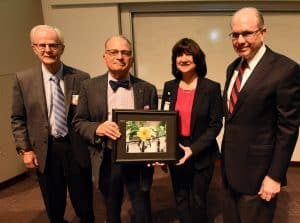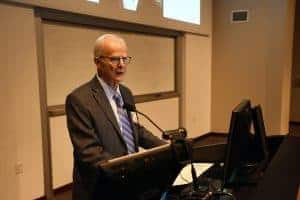Vietnam Vet, Now Ophthalmologist, Recounts Years as POW
| Feb. 15, 2018 | F. Harold Kushner was four months into his deployment as an Army flight surgeon in the Vietnam War when a driving rainstorm caused the helicopter he and three other soldiers occupied to crash into the side of a mountain in the middle of enemy territory.
The pilot was killed on impact. The co-pilot was gravely injured, crushed against the chopper’s instrument panel with bones protruding from his leg. The crew chief had been thrown from the aircraft and lay unconscious on the ground.
Kushner was unconscious, still strapped into his seat. When he came to, the chopper was ablaze.
Now an accomplished ophthalmologist in Daytona Beach, Florida, he spoke at UAMS on Feb. 7 in the UAMS Winthrop P. Rockefeller Cancer Institute’s Walton Auditorium.
Kushner spent five and a half years as a prisoner in the Vietnam War. Following his release, John P. Shock, M.D., founding director of the UAMS Harvey & Bernice Jones Eye Institute, mentored Kushner during his ophthalmology residency at Brooke Army Medical Center in San Antonio.
Kushner related his harrowing yet inspiring story of survival to UAMS students, faculty and staff.
After freeing himself from the chopper, Kushner worked to free the co-pilot, but was forced to jump from the aircraft when it was engulfed in flames in what Kushner recalled as a “big whoosh.” The inferno caused the chopper’s attached M60 machine gun to fire off multiple rounds that pierced Kushner’s body through the back and left shoulder.
Kushner’s pants were burned off his body and he sustained burns to his legs and back. He was missing several teeth, his glasses were gone and he realized his left collarbone and both bones in his left forearm were broken.
By the light of the chopper’s fire, he could see the co-pilot and crew chief on the ground, still alive. With no supplies other than two .38 pistols, six rounds in each weapon, the three soldiers, members of the 1st Squadron’s 9th Cavalry Regiment, huddled under one of the chopper’s doors as the torrential rains continued through the night.
The next morning, the crew chief was sent to find help, but never returned. He was later found killed in a field, ten miles from the crash site.
“The rule they teach you in survival school is to stay with your airplane,” said Kushner. “We stayed for three days and three nights.”
The morning of the third day, Dec. 2, the co-pilot died. Kushner was alone.
“I took the compass from the airplane and moved east by the compass, zero-nine-zero,” said Kushner. “I followed that compass and went down the mountain, my left arm strapped to my body with an army belt.”
The next morning’s light revealed his terrible error. The compass had failed him.
“I had not gone east,” he said. “I had gone west. I had gone the wrong way because the compass was broken and was reading 180 degrees off.”
Kushner watched as Army choppers hovered over the mountainside he’d left the day before. The crash site would be found the next day.
Kushner continued down the mountain and met a man working in a rice field. The man led him a mile further down a path and to a hut where he retrieved a can of condensed milk, a plastic spoon and a can opener.
“That stuff just billowed out of the can,” said Kushner. “It was the greatest stuff I’ve ever eaten.”
His first meal in four days was cut short as a squadron of Viet Cong soldiers approached, commanding him to raise his hands and surrender. Kushner raised his right arm, as his left remained strapped down. One of the soldiers shot him in the shoulder.
“They took all my possessions, I showed them my Geneva Convention card, which identified me as medical personnel,” said Kushner. “He tore it up and said, ‘No POW, no POW. Criminal.’”
Kushner spent the next month tightly bound and marching through the South Vietnam jungle. Traveling at night and sleeping during the day to avoid detection, the group forced Kushner to walk in front of it through rice fields on 18-inch wide levees with no light to guide his steps.
“I would fall off the dike and into the water, I didn’t have shoes or boots, my feet were lacerated,” said Kushner. “They pulled me up out of the water by my bondage. It was rough.”
Eventually, he reached what he said “was to be his home” for the next couple of years, although the camp itself would move often, a day’s or two days’ hike through the jungle each time. It was a muddy clearing in the jungle located next to a stream with a few huts and “four of the saddest looking American creatures I had ever seen in my life.”
Twenty-seven American POWs passed through the camp and “ten of them died in my arms,” said Kushner. The prisoners went without shoes, clothes, mosquito nets and medicine. They survived on rice that had been had been stored for 15 years and contained rat feces, rocks and weevils.
“Which we ate,” said Kushner.
Each man constantly suffered from multiple conditions, including malaria, dysentery and malnutrition. Despite subhuman living conditions and what Kushner called “intense indoctrination,” he said they found ways to survive.
“We were Americans and we stayed together,” said Kushner
On American holidays, the group would quietly sing patriotic songs as to not alert their captors.
“We nursed each other, we cleaned each other and we took care of one another,” he said.
In 1971, the dozen prisoners were moved to North Vietnam as their captors feared the group would die without better rations, said Kushner. The prisoners were divided into two groups of six, a fast group and a slow group, with Kushner in the former.

Kushner was presented a photograph of the gatehouse at the Hanoi Hilton by John P. Shock, M.D., JEI founding director; Stephanie Gardner, Pharm.D., Ed.D.; and Christopher Westfall, M.D., JEI director.
The groups walked 560 miles, over 57 days for the fast group and 180 days for the slow group, to a train station before traveling to the infamous Hanoi Hilton in North Vietnam.
Kushner and five other prisoners were put in a 10-foot by 14-foot cell with six wooden pallets, a cement floor, no windows, no electricity, no water and only a slit in the door. They received pumpkin soup, hog water and a piece of bread, twice a day. Kushner said he later calculated the daily rations at about 600 calories.
“It was a cruel jail,” said Kushner, adding that propaganda was piped through loudspeakers. “It was terribly hot in the summer, and dank and damp and cold in the winter. But no one died.”
In December of 1972, B-52 bombers began battering Hanoi in Operation Linebacker II. Kushner said he and his fellow captives cheered as the payloads were dropped. A day after the bombing started, the camp’s commander gave the prisoners a shovel and pick to build a shelter if they chose.
“It was hard with a cement floor,” said Kushner. “But we shared the work and dug a pit and covered it with our pallets.”
The bombings would continue for 12 days.
“When the bombings resumed, we jumped in the hole, covered it and cheered them,” Kushner said.
Peace was reached Jan. 27, 1973 in Paris Peace Accords. Kushner was headed home; however, it would be another two months before he would reach America.
On March 16, 1973, Kushner walked out of a shed at Gia Lim Airport in Hanoi to a C-141 Starlifter with an American flag emblazoned on the tail. It was the first time in five and a half years he’d seen the flag.
“I was overwhelmed,” he said. “I almost fainted. I can’t describe the deep emotion that I felt when I saw it.”
After a short stint at a hospital in the Philippines, Kushner returned to American soil in Hawaii. Upon debarking the plane, he sang “America the Beautiful.”
“I swore to myself I would sing that if I ever got back to American soil,” he said. “There were 1,500 people receiving us at three in the morning, including a bunch of reporters. They all joined in with us in singing.”
He met his then-five-year-old son for the first time and greeted again his daughter, then in the fifth grade. Kushner was on convalescent leave for the next few months and used the time to travel the country and visit the families of those POWs who perished while imprisoned with him.
He returned to duty in August 1973 and restarted his medical career. Kushner left active-duty service in 1977 and retired from the Army Reserve in 1986 as a colonel.

John P. Shock, M.D., JEI founding director, who introduced Kushner, was his chief during the last year of Kushner’s ophthalmology residency at Brooke Army Medical Center in San Antonio.
Kushner completed two residencies at Brooke Army Medical Center in San Antonio, including one in ophthalmology. UAMS’ Shock served as his chief the final year of his residency.
“Col. Shock,” as Kushner referred to him was a “wonderful mentor and for the last 42 years, has been a treasured and trusted friend.”
Following Kushner’s lecture, Shock presented Kushner with a framed photograph taken of the Hanoi Hilton’s gatehouse, all that remains of the prison that was destroyed in the 1990s and transformed into a museum. The photographers, Mary and Marie Ryan, were in attendance at UAMS.
Interim UAMS Chancellor Stephanie Gardner, Pharm.D., Ed.D., said she was most moved by the compassion shown between the prisoners that carried them through.
“I thank you for that, and for what you’ve done for your country and how your story continues to inspire us,” said Gardner.
Kushner hasn’t allowed his war experiences to overshadow his life. He’s enjoyed a long, successful career as an ophthalmologist and credits his medical career to Shock.
His patients are aware of his military past, especially since Kushner was featured in Ken Burns’ Vietnam War documentary, but Kushner says “my patients and I don’t talk about it, that’s not what they think about me.”
He said he feels lucky to have survived his imprisonment “when so many stronger, better-trained men died,” and to have avoided post-traumatic stress disorder and flashbacks.
“I’ve done missions all over the world on every continent except Antarctica and I just feel so lucky that I was born an American,” he said. “I love my country so much and I’m just proud and honored that I could serve it under the most difficult and harrowing circumstances and I could return with even more love for my exceptional America.”
